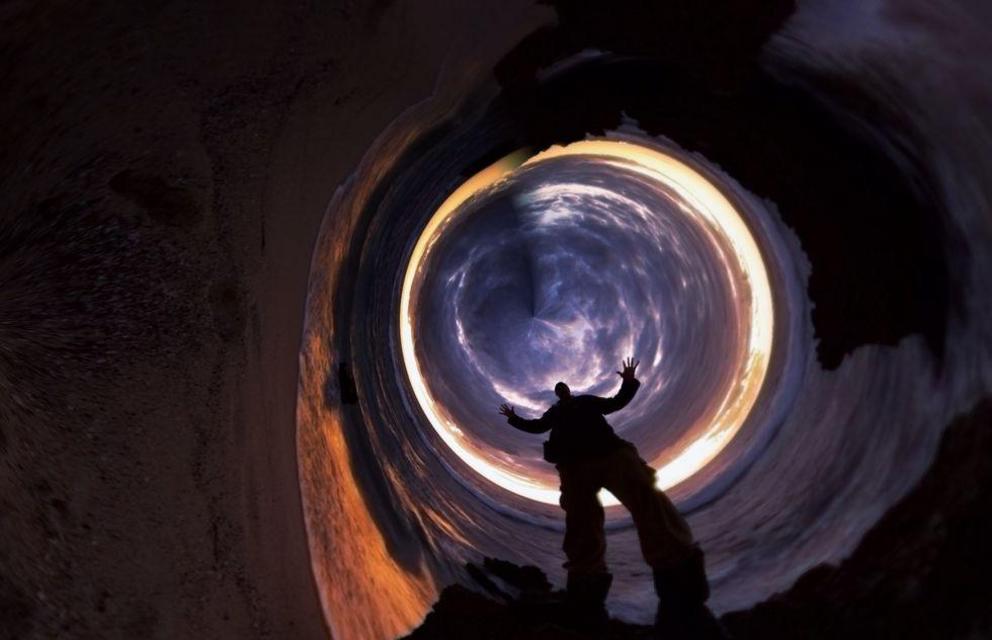Human-safe wormholes could exist in the real world, study finds
Pack your bags. We're going to another galaxy.
- Traversable wormholes may be more than science fiction, new research suggests.
- Two separate studies published in Physical Review Letters D propose new theories for how to construct a traversable wormhole.
- Wormholes, also known as an Einstein-Rosen bridge, are commonly used in sci-fi stories as a way to quickly zip between distant parts of the universe.
Sci-fi writers have long leaned on the wormhole as an important plot device. It’s a quick way to get characters from point A to point B, across the vast distances in spacetime, in a matter of seconds.
Theorists like Albert Einstein and Kip Thorne have been pondering the existence of these spacetime portals for decades, but so far, no one has been able to provide physical evidence of their existence. Perhaps until now.
Two new studies, published in the journals Physical Review Letters and Physical Review D, propose that wormholes safe enough for humans to travel through could exist in the real world after all.
This content is imported from {embed-name}. You may be able to find the same content in another format, or you may be able to find more information, at their web site.
One of the main arguments against the existence of wormholes suggests the portal’s narrowest part, or neck, would likely collapse under the weight of its own gravity. Some theorists say one way to sidestep this issue and prevent gravitational collapse would be to fill the wormhole with an exotic form of matter that has negative mass. But this solution isn’t a cosmological silver bullet—such a form of matter is purely theoretical.
In the first new paper, an international trio of researchers led by Jose Blázquez-Salcedo of the Complutense University of Madrid have proposed an alternative way to prevent the collapse of a fragile wormhole’s neck—one that doesn’t need exotic matter to keep the wormhole propped open.
Instead, their theoretical models, which ponder the possibility of microscopic wormholes, draw from three theories to harness the power of elementary particles: relativity theory, quantum theory, and electrodynamics.
These scientists suggest tweaking the mass and charge of fermions—fundamental building blocks of matter—could keep the cosmic thruway open. This would only work if the ratio of the total charge of the fermions to the total mass of everything inside the wormhole is greater than the practical limit set by black holes.
This telescope features a 70mm aperture and comes with fully coated optimal lenses to offer a crisp, clear view of the night's sky. Tech-savvy stargazers will appreciate the smart phone adapter and wireless camera remote, making it possible to view constellations from your screen.
All you need to do is point the tube in the direction of the desired object and take a gander. With two high-quality eyepieces (70mm and 360mm) that provide low- and high-power views of celestial objects, you'll be able to satisfy your stargazing wishes with ease.
This option features a wide, 70-millimeter aperture that will make stars and constellations appear bright and clear. It also has a smartphone adapter so you can view everything directly from your screen.
Using this telescope is easy: All you need to do is point the tube in the direction of the desired object and take a gander. Two eyepieces make it possible to easily score a wide or narrow view of the sky.
Now, there’s a catch: Blázquez-Salcedo and his team are talking about microscopic wormholes. They’re not exactly traversable by humans, but this is certainly one small step in a new theoretical direction.
The second paper, however, which comes from Juan Maldacena of the Institute for Advanced Study in New Jersey and Alexey Milekhin from Princeton University, does explore the theoretical existence of wormholes large enough for spacetime-surfing humans to squeeze through.
In this case, Maldacena and Milekhin have devised a wormhole that forms in five-dimensional spacetime, also known as the Randall-Sundrum model. These wormholes would look like intermediate-mass black holes to the untrained observer, the authors say.
If you hopped in this kind of wormhole, you’d experience up to 20 g of acceleration—an uncomfortable, albeit survivable amount. But the authors acknowledge some practical limitations with this theory. For example, the wormhole has to be extremely clean—i.e., free from errant particles:
"If particles that fall into the wormhole scatter and lose energy then they would accumulate inside, contributing some positive energy that would eventually make the wormhole collapse back into a black hole."
The last place anyone traveling through space wants to end up is at the center of a black hole. (Or is it?) They also have to be extremely cold, the researchers write. And then there’s the small problem of actually generating the wormhole in the first place. Maldacena and Milekhin are still working on figuring out how to form one.
The good news? Theoretically, your cross-galaxy trip would only take less than a second. But if your family and friends are tracking your journey from outside the wormhole, they’ll be waiting a long time for it to end. From their perspective, your trip would last tens of thousands of years.
Looks like you’ll have to find your own ride home.

